Fixed Teeth With Dental Bridge At Perfect Dental® In Jamnagar
Our team of doctors has a specialist dentist for best teeth replacement in Jamnagar
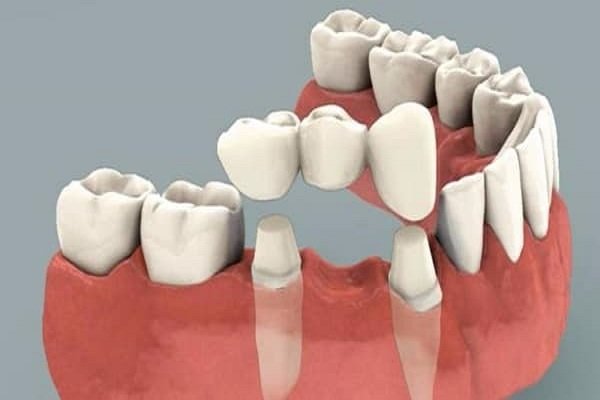

A dental bridge is a false tooth that is held in place by the abutment teeth (healthy teeth on either side of the gap). Although pontics can be made from a variety of materials such as gold, typically they are made from porcelain to aesthetically blend in with your natural teeth.
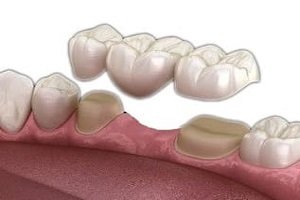
A traditional dental bridge consists of a false tooth or teeth being held in place by dental crowns that have been cemented onto each of the abutment teeth. A traditional bridge is the most popular type of dental bridge and can be used when you have natural teeth on both sides of the gap created by your missing tooth.
Cantilever Dental Bridge is similar to a traditional bridge, the pontic in a cantilever dental bridge is held in place by a dental crown that is cemented to only one side abutment tooth/teeth. Cantilever Dental Bridge is used especially when you have natural tooth/teeth only on one side of gap.
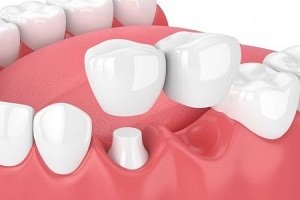
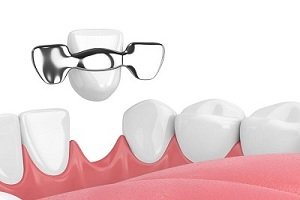
Similar to a traditional bridge, Maryland dental bridges employ two natural abutment teeth, one on each side of the gap. However, while a traditional bridge uses dental crowns on the abutment teeth, a Maryland bridge uses a framework of either metal or porcelain that is bonded onto the backs of the abutment teeth.
Like a traditional bridge, a Maryland bridge can only be used when you have a natural tooth on each side of the gap caused by the missing tooth or teeth.
Implant supported dental bridges use dental implants as opposed to crowns or frameworks. Typically, implants are surgically placed on either sides of gap created by missing tooth/teeth, and these implants hold the bridge in position. Implant supported dental bridge is used when one implant for each missing tooth isn’t possible, the bridge may have a pontic suspended between two implant supported crowns.
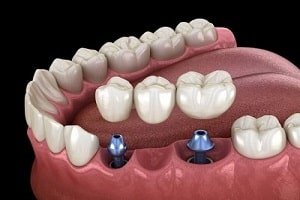
When you have missing tooth/teeth, it can affect you in a number of ways. A dental bridge can address following:
Stainless steel dental bridges are the most commonly used dental bridges for replacing missing molars in India as they are very cost effective option. Stainless steel dental bridges are ideal choice for restoring missing molars as they can resist biting and chewing forces and don’t break or chip off easily. Since they aren’t tooth colored, they cannot be used to restore front teeth.
These are generally made from alloys that are noble or base-metal alloys. Noble Metal Dental Bridges are ideal choice for restoring missing molars as they can resist biting and chewing forces and don’t break or chip off easily. Since they aren’t tooth colored, they cannot be used to restore front teeth. In our practice we consider Noble Metal Dental Bridges as out-dated as they do not offer any cost benefits to patient and there are many better options available compared to Noble Metal Dental Bridges.
PFM Bridges provide best of both the worlds. They have metal’s strength and porcelain’s aesthetics. PFM bridges are the second best in terms of providing natural tooth like color after Zirconia. However, porcelain part of the bridge does tend to chip off if subjected to heavy masticatory forces. Sometimes the metal lying underneath such bridge can be seen as dark line especially near the gum margin. So in our practice we use these crowns for back teeth restoration or when patient cannot afford zirconia bridges.
Zirconium dental bridges are a CAD CAM milled all-ceramic bridges that are mainly used for front and back teeth crown and bridges and as implant abutments. It has zirconia as substructure and porcelain stacked on it for optimum aesthetics. There are many brands of this product and some have higher clinical success rates. Some of these are 3M Lava, Cerec, Bruxzir, etc.
Perfect Dental® has highly talented cosmetic dentist in Jamnagar who render beautiful smiles by fabricating life like crowns and bridges. Based on your individual requirement, our team of dental professionals help you to select the right type and material of crown for you, so that you get the amazing radiant smile.
Dental bridges can last five to 15 years and even longer. With good oral hygiene and regular checkups, it is not unusual for the life span of a fixed bridge to be over 10 years.
It is very common for a bridge to replace 2, 3, 4 or even more teeth as long as there are enough abutment teeth to connect to with crowns. Also, implants can be strategically placed to be used to replace teeth, either as free standing teeth or as support for a bridge using natural teeth and implants.
Perfect Dental® is the best dental center in Jamnagar for dental bridge and fixed teeth replacement. Our specialist dentists are expert in teeth replacement with dental bridge.
There is a common misconception circulating that dental bridges aren’t sturdy and will eventually fall out. While bridges do sometimes loosen over time, they can easily be fixed by your dentist. However, they’re built to last a lifetime, so the chances of your bridge falling out are miniscule.
With technological advancement, dental bridges can be made to look very natural, so nobody will be able to tell just by looking at you that you are missing some of your natural teeth. If you care for your dental bridge properly, it can last fifteen years or more, allowing you to speak and eat comfortably.
Although a new all-ceramic tooth bridge can be fitted immediately after a tooth has been extracted, because of the swelling and resulting gap in the jawbone that may occur, in some cases it’s better to wait a 8-12 weeks for the jawbone surrounding the position of extracted tooth to heal over completely.
The dental bridge should feel nearly as real and comfortable to you as your natural teeth did. Many of our patients report that their bridges feel even better than the natural teeth did prior to bridge placement, especially if these teeth had large fillings or restorations in them.
Just because you can’t see a missing tooth doesn’t mean it won’t cause problems in the long term. Your back teeth (molars) do the most work – the chewing, so losing a tooth in this area could make it harder to eat your favorite foods. The space created due to missing tooth can make adjacent teeth to gap and opposing tooth to move into the space to fill a missing tooth, causing a misalignment between your upper and lower teeth.
Perfect Dental® is the best dental clinic in Jamnagar and our team of specialist doctors is highly skilled and experienced best dentists in Jamnagar. We have a highest success rate of 97%.

Dr. Chandani
Doctor
Dr. Chandani
Hey, how can I help you today?
Powered by Elementor